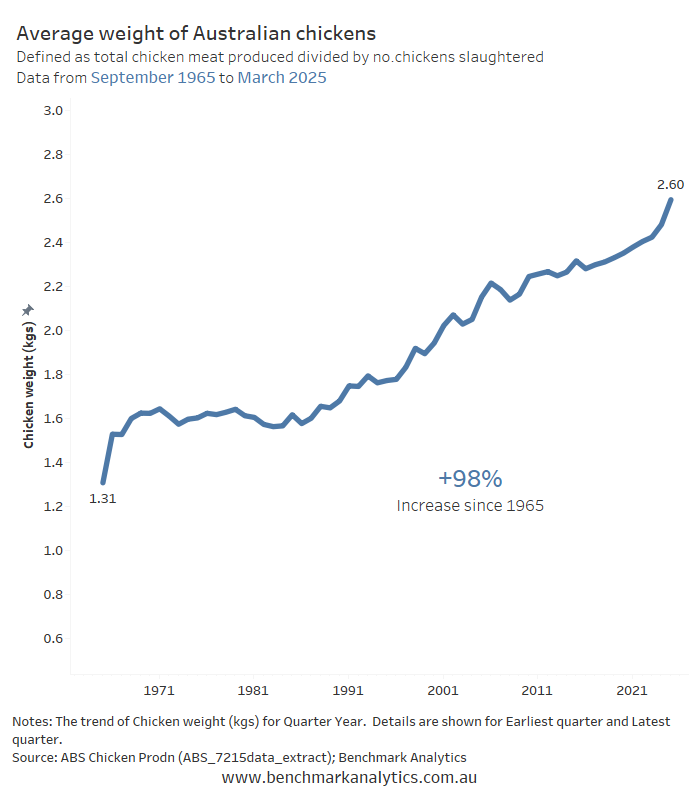2.6 vs. 2.8 kg chickens - why?
Data alert | Meat production data released today
Today, the ABS released its quarterly Livestock Products publication, which provides figures on the number of animals slaughtered and the amount of meat produced.
By dividing total meat production (in kilograms) by the number of animals or birds slaughtered, one can estimate the average weight of each animal or bird.
This data has long been a source of controversy—particularly when it comes to chickens. The average chicken size has steadily increased since the 1960s, and it’s alleged that this growth is driven by aggressive farming techniques, including the use of hormones and feed supplements designed to extract more saleable meat per animal.
Measuring the “true” weight of a chicken is more complex than it seems. It depends on the purpose of the measurement. In Australia, the relevant figure for meat production is the weight of broiler chickens at slaughter. This refers to the dressed weight—after slaughter and evisceration—representing the carcass weight delivered for sale (excluding feathers, blood, viscera, etc.).
According to the latest data, the average dressed weight of a broiler chicken in Australia is about 2.6. In the United States, that figure is higher—2.8 kilograms, or roughly 8% heavier.
Assuming the same variety of chicken is used, why are American chickens yielding more meat?
One reason appears to be the heavier use of a class of feed additives called ionophores.
A key difference between US and Australian chicken production lies in the use of ionophores—antimicrobial compounds added to animal feed not to treat illness, but to promote growth and enhance feed efficiency. Ionophores work by altering the permeability of cell membranes in certain gut bacteria and protozoa, improving nutrient absorption and reducing infection risks in intensive farming environments.
Although ionophores are technically antibiotics, they are not used in human medicine. As a result, US regulators generally do not consider their use to contribute to antimicrobial resistance in humans—a view not universally shared.
In the European Union and Australia, ionophores are either tightly restricted or discouraged from routine use. While Australian regulations permit their use in limited veterinary contexts, the kind of routine, subtherapeutic dosing common in the US is not allowed. In practice, this means Australian chickens are raised without the constant medicinal boosting that American chickens receive as a matter of course.
Another reason why US chickens are heavier
While the use of ionophores is likely the technical or scientific explanation for heavier chickens in the United States, it also reflects a deeper cultural difference in entrepreneurial drive between the US and Australia.
In Australia, public policy tends to favour caution and bureaucratic control. Bureaucrats and politicians are rarely penalised for blocking innovation—but they are swiftly blamed when something they've allowed goes wrong. As a result, the system is more wired to inhibit rather than to enable.
There is, in fact, insufficient evidence that ionophores are harmful to human health. On the contrary, by improving the health and efficiency of poultry, their use may even have indirect human benefits. US chicken producers have had more success in challenging regulators and getting approval of such technologies.

More details about the statistical collection of chicken slaughtering and meat production
Statistics for chicken slaughtering, chicken meat produced and gross value of poultry slaughtered have been compiled from quarterly returns supplied by commercial poultry slaughtering establishments and comprise broilers, fryers and roasters.
Many small producers are excluded from the collection; however, the statistics represent a high level of coverage.
Australian totals for poultry exclude Northern Territory and Australian Capital Territory due to limited activity undertaken in those territories.
Chicken meat is shown in dressed weight of whole birds, pieces and giblets.
Poultry statistics relate to slaughtering for human consumption and do not include animals condemned, slaughtered for pet food or those killed for boiling down. See ABS wesbsite here.
Other methodological information about the statistics
Scope
Includes livestock and poultry slaughtering at registered abattoirs, meat production for human consumption and gross value of livestock slaughtered.
Geography
Data available for Australian and state totals.
Source
Data is sourced from commercial abattoirs and meat processors.
Collection method
A quarterly survey of commercial abattoirs and meat processors.
History of changes
The Wool Purchases, Receivals and Sales Survey and data release (Table 16) was ceased in September 2022.